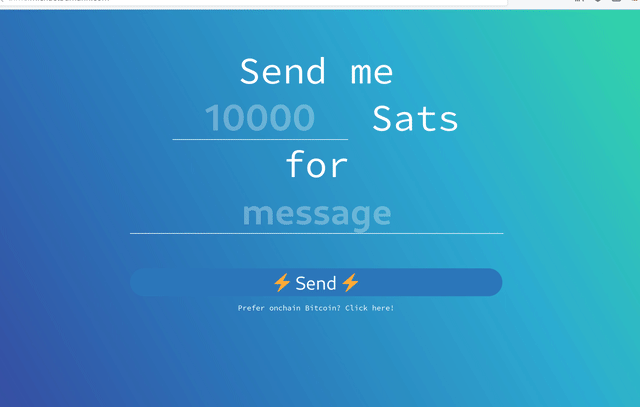# LnMe - your friendly ⚡ payment page
LnMe is a personal Bitcoin Lightning payment website and payment widget.

It is a small service written in Go that connects to a [lnd node](https://github.com/lightningnetwork/lnd/blob/master/docs/INSTALL.md) and exposes a simple HTTP JSON API to create and monitor invoices.
It comes with a configurable personal payment website and offers a JavaScript widget to integrate in existing websites.
If [webln](https://github.com/wbobeirne/webln) is available the widget automatically use webln to request the payment;
otherwise an overlay will be shown with the payment request and a QR code.
## Motivation
I wanted a simple way for people to send Lightning payments using my own lightning node.
BTCPay Server is too big and hard to run for that and I do not need most of its features.
## Installation
LnMe connects to your [LND node](https://github.com/lightningnetwork/lnd/blob/master/docs/INSTALL.md), so a running LND node is required.
LnMe can easily run next to LND on the same system.
1. Download the latest [release](https://github.com/bumi/lnme/releases)
2. Run `lnme`
3. Done.
### Build from source
1. $ git clone https://github.com/bumi/lnme.git && cd lnme
2. $ go install
3. $ rice embed-go && go build
4. $ ./lnme
### Configuration
#### LND configuration
To connect to the lnd node the cert, macaroon and address of the lnd node has to be configured. LnMe uses the LND defaults.
* `address`: Host and port of the lnd gRPC service. default: localhost:10009
* `cert`: Path to the lnd cert file. default: ~/.lnd/tls.cert
* `macaroon`: Path to the macaroon file. default: ~/.lnd/data/chain/bitcoin/mainnet/invoice.macaroon
#### Other configuration
* `static-path`: Path to a folder that you want to serve with LnMe (e.g. /home/bitcoin/lnme/website). Use this if you want to customize your ⚡website. default: disabled
* `disable-website`: Disable the default LnMe website. Disable the website if you only want to embed the LnMe widget on your existing website.
* `disable-cors`: Disable CORS headers. (default: false)
* `bind`: Host and port to listen on. (default: :1323)
* `request-limit`: Limit the allowed requests per second. (default: 5)
#### Examples:
$ lnme --help
$ lnme --address=lndhost.com:10009 --bind=localhost:4711
$ lnme --disable-website
### Deployment
To run LnMe as systemd service have a look at the [systemd service example config](https://github.com/bumi/lnme/blob/master/examples/lnme.service)
I am running LnMe behind a reverse proxy using [caddy](https://caddyserver.com/) which comes with [fully-managed HTTPS](https://caddyserver.com/docs/quick-starts/https) via [letsencrypt](https://letsencrypt.org/).
Example Caddyfile:
```
lnme.michaelbumann.com {
reverse_proxy 127.0.0.1:1323
}
```
`$ caddy --config /etc/caddy/Caddyfile`
### Customize your ⚡ website
LnMe comes with a default website but you can easily configure and build your own using the the LnMe JavaScript widget or JSON API.
Take a look at the [embedded default website](https://github.com/bumi/lnme/blob/master/files/root/index.html) for an example and use the `--static-path` option to configure LnMe to serve your static file.
1. Create a new folder (e.g. /home/satoshi/my-ln-page)
2. Create your index.html
3. Run lnme: `lnme --static-path=/home/satoshi/my-ln-page
### JavaScript Widget integration
You can integrate the LnMe widget in your existing website.
#### 1. Add the LnMe JavaScript files
```html
```
#### 2. Usage
To request a lightning payment simply call `request()` on a `new LnMe({value: value, memo: memo})`:
```js
var lnme = new LnMe({ value: 1000, memo: 'high5' });
lnme.request();
```
Use it from a plain HTML link:
```html
Tip me
```
##### More advanced JS API:
```js
let lnme = new LnMe({ value: 1000, memo: 'high5' });
// get a new invoice and watch for a payment
// promise resolves if the invoice is settled
lnme.requestPayment().then(invoice => {
alert('YAY, thanks!');
});
// create a new invoice
lnme.addInvoice().then(invoice => {
console.log(invoice.PaymentRequest)
});
// periodically watch if an invoice is settled
lnme.watchPayment().then(invoice => {
alert('YAY, thanks!');
});
```
## Development
Use `go run` to ron the service locally:
$ go run lnme.go --address=127.0.0.1:10009 --cert=/home/bitcoin/lightning/tls.cert --macaroon=/home/bitcoin/lightning/invoice.macaroon
## Build
LnMe uses [go.rice](https://github.com/GeertJohan/go.rice) to embed assets (HTML, JS, and CSS files). run `rice embed-go`
$ rice embed-go
$ go build
## Contributing
Bug reports and pull requests are welcome on GitHub at https://github.com/bumi/lnme
## License
Available as open source under the terms of the [MIT License](http://opensource.org/licenses/MIT).